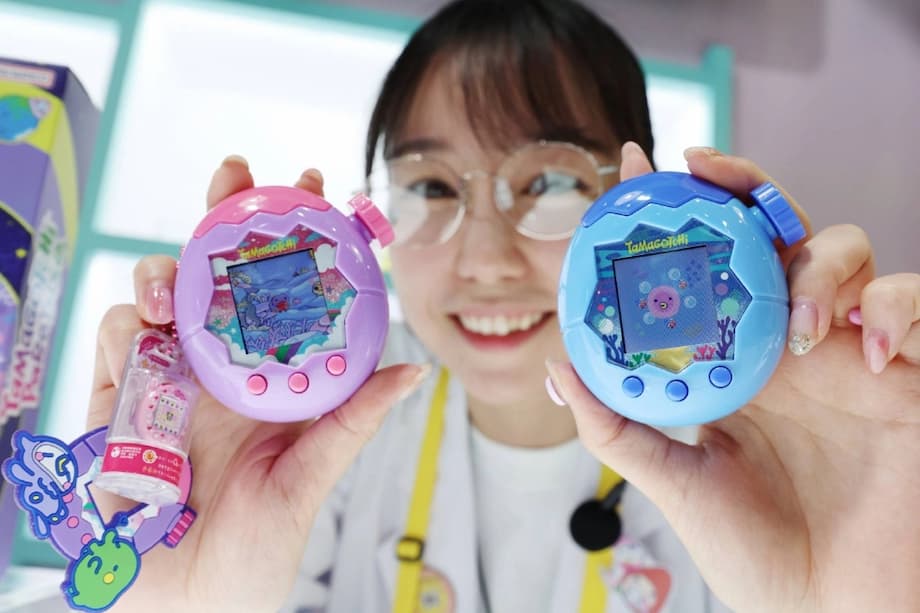A milestone three decades in the making
Tamagotchi has crossed 100 million shipments worldwide as of August 2025, according to Bandai. The tiny virtual pet, born in Japan in November 1996, has been sold in about 50 countries and regions and released in 37 distinct models. Nearly thirty years after the first craze, interest is surging again, with Japanese media describing a fourth wave of popularity this year. The renewed momentum reflects a blend of retro appeal, clever product refreshes, and a growing audience of adults who now buy toys for themselves and their families.
- A milestone three decades in the making
- How nostalgia and the kidult market revived a 90s icon
- A steady evolution from three buttons to Paradise
- Who is buying and where demand is coming from
- The wider retro toy wave lifting all boats
- Culture, criticism, and classroom memories
- Business stakes for Bandai
- Technology meets community
- Key Points
The device’s comeback speaks to a potent mix of Japanese pop culture memories and consumer behavior. Bandai Namco’s steady stream of updates has kept the brand present, yet the spark in 2025 is especially linked to the kidult market, a multibillion dollar segment of teens and adults, as reported by The Japan Times. Toy analysts also point to nostalgia’s power to offer escapism and comfort amid a busy digital life. Many early fans now have children, turning personal memories into family purchases.
The first wave set the template. Early models sold out quickly in Japan, with long lines at shops, then expanded abroad from 1997 and found a devoted audience in the United States. The premise remained simple: a creature hatches from an egg, the owner feeds, cleans, and plays with it, and the pet grows in different ways depending on care. That straightforward loop still anchors the brand today.
How nostalgia and the kidult market revived a 90s icon
Nostalgia has become a clear driver in the toy aisle. Adults and older teens increasingly buy for themselves, seeking familiar characters and simple play loops that feel reassuring. In the United Kingdom, nearly 1 pound in every 3 spent on toys last year came from adults and teens, according to reporting in The Times. That spending meets a steady stream of revamped classics, from Care Bears to Subbuteo, and a marketplace eager for throwbacks that feel both fresh and familiar.
Search and sales data reflect the trend. Jungle Scout’s analysis of Amazon activity shows sharp spikes for 1990s brands. It identified a 616 percent increase for one Tamagotchi model and more than 900 percent growth for a Pac Man Tamagotchi during monitored periods. Furby sales rose by triple digits and other staples like the Magic 8 Ball and Polly Pocket also trended higher. On social platforms, hashtags tied to Tamagotchi draw millions of views each month, helping older fans reconnect while introducing the device to a new generation.
Inside Bandai, the narrative is about more than nostalgia. A senior executive who helped develop the earliest model describes a lasting emotional hook that keeps players coming back, even as features change over time. Bandai’s managing director and CTO, a veteran of the original development, framed the product’s enduring appeal in values that transcend eras.
Tamagotchi has allowed people to experience the joy of caring, the fun of nurturing, and the value of life. We aim to keep evolving the toy to bring joy and inspiration across generations and borders.
A steady evolution from three buttons to Paradise
The first Tamagotchi offered a compact case, three buttons, and a small monochrome screen. Players fed, cleaned, and entertained a creature that changed appearance based on attention and timing. The loop rewarded routine and responsiveness. Over the years, Bandai updated the experience without losing that core. In 2004, new models added infrared communication so two pets could share data. In 2008, color screens made the small characters livelier. Later releases experimented with connectivity, more detailed worlds, and special crossover themes.
Recent years have brought a bigger leap in hardware design. A wearable version arrived in 2023 with a touch screen and vivid color graphics. In July 2025, Bandai launched Tamagotchi Paradise, the 37th model. Pricing reflects rising component costs. Asahi reports a price of 5,800 yen before tax. Mainichi lists 6,380 yen, which matches the typical 10 percent consumption tax in Japan. The higher price has not dampened curiosity, as preorders for Paradise outpaced earlier expectations and first week sales exceeded projections.
What Tamagotchi Paradise changes
Paradise adds a physical dial that lets players zoom out to view their pet from a cosmic perspective or zoom in to a cellular level. It is a playful way to watch growth and health. Two devices can connect so characters can meet, battle, become family, and have children. Mainichi reports more than 50,000 possible growth patterns in the latest model and mentions a memorial feature designed to prompt reflection about care and life. The new device omits WiFi, which brings the focus back to the handheld loop, while still allowing device to device interactions that feel social and fun.
The update aims for a balance between novelty and familiarity. Fans get fresh mechanics without losing the quick, in-the-pocket routine that made Tamagotchi easy to check throughout the day. The zoom feature adds texture to a classic formula, and the return to a more analog feel helps keep the experience focused on play rather than apps and notifications.
Who is buying and where demand is coming from
The audience for Tamagotchi now spans multiple life stages. Many teens meet the device for the first time, while adult fans are returning to a favorite from childhood, often buying a second unit for kids at home. Priya Jadeja, Tamagotchi’s brand manager in the UK, told nss magazine that the company initially expected nostalgia to dominate after a 2019 relaunch, yet interest among younger children grew far more than planned. That mix is fueling the current wave.
Geography is shifting too. Company figures cited by nss magazine indicate that roughly 49 percent of buyers are in Japan, with the United States at 33 percent and Europe at 16 percent, while the rest of Asia is about 2 percent. Those shares show how much overseas demand has grown since the late 1990s. Bandai has reinforced that presence with retail experiences, including a Tamagotchi flagship store opened in London’s Camden Market in September 2024.
Community energy amplifies the cycle. On TikTok and X, the hashtag for Tamagotchi gathers millions of views, with hundreds of thousands of monthly searches reported by nss magazine. Fans share care strategies, shell customization, and short clips that turn the device into both a game and a badge of identity.
The wider retro toy wave lifting all boats
Tamagotchi’s surge is part of a broader return for retro brands. Reporting in The Times highlights how revamped lines from the Eighties and Nineties are selling again, including Care Bears, Stretch Armstrong, Sylvanian Families, Subbuteo, Pac Man, and more. The British Toy and Hobby Association has tracked a clear jump in purchasing by adults and teens. That spending, combined with updated formats and brand collaborations, keeps legacy names visible across both traditional retail and social media.
Online marketplaces show how sharp those peaks can be. Jungle Scout’s holiday and evergreen data found a 616 percent sales jump for a Tamagotchi model during tracked periods and more than a 900 percent spike for a Pac Man Tamagotchi variant. Furby saw increases in the 200 percent range, while Beanie Babies ticked up in unit sales. Similar bumps appeared for the Magic 8 Ball, Polly Pocket, and Lisa Frank items. The same playbook works for Tamagotchi: a simple loop, a familiar shape, and then a modern twist that stands out in feeds and storefronts.
Brand crossovers add fresh points of entry. Tamagotchi has partnered with Sanrio and streetwear names such as BAPE, and fashion houses have experimented with capsule collections, including a collaboration cited by nss magazine with Max Mara. The device is also a stylized accessory. Many owners clip it to bags as a charm, blending a toy with fashion in a way that fits personalization trends.
Culture, criticism, and classroom memories
Tamagotchi emerged in a Japan that excelled at compact personal electronics. The 1990s saw the popularity of portable music players, Game Boy, and early mobile phones. The device took that portable mindset and added a care loop that rewards attention. Fans often link the bond to Japanese ideas of kawaii (cute design) and omoiyari (empathy). Community accounts and forums recall how Tamagotchi slipped into daily routines, sometimes even into schools, to the frustration of teachers who saw students sneaking checks between classes.
The early fad also drew criticism. During a 20th anniversary reissue, South China Morning Post recalled how parents and educators debated the toy’s dying mechanic and the demand for frequent checks. That conversation never stopped the spread across borders. The brand adjusted features over time while keeping the life cycle intact. Owners still feel responsible for a tiny creature that needs food, cleaning, and play, which is a big part of the charm.
Business stakes for Bandai
Bandai has built an ecosystem around the brand. Mainichi reports that related businesses such as candy toys and cosmetics have grown alongside the core device, and that console titles returned to Nintendo Switch, pulling new players into the world. The company is also planning events for the 30th anniversary in 2026. That calendar gives the brand a steady drumbeat of content and experiences beyond the handheld hardware.
The 100 million shipment mark underlines both scale and staying power. Tamagotchi’s loop is easy to grasp and can be reimagined with each hardware generation. The company’s strategy pairs small but meaningful innovations with partnerships and retail moments that keep the brand visible from Tokyo to London and beyond. The result is a product that speaks to new players while sparking memory in those who grew up with it.
Technology meets community
Recent versions show how far the brand can stretch. A wearable released in 2023 put the pet on the wrist with a touch screen and bright color graphics. nss magazine describes a 2024 device that pushes resolution and display quality well beyond the 8 bit look of the 1990s. Some editions connect to online spaces, such as a Tamaverse, where owners can interact beyond the physical device. Paradise, in contrast, leans into hands on play without WiFi, keeping the focus on what players do on the device itself.
Social media ties the ecosystem together. Countless short videos walk through care routines, showcase rare character paths, or show off custom shells and cases. This activity links generations through shared tips and the spectacle of a small creature that mirrors attention and care. Even as features change, that loop remains the beating heart of the brand.
Key Points
- Bandai says Tamagotchi has surpassed 100 million shipments worldwide as of August 2025.
- The brand has launched 37 models and is sold in about 50 countries and regions.
- 2025 is described as a fourth wave of popularity, driven by nostalgia and the kidult market.
- Tamagotchi Paradise, released in July 2025, adds a zoom dial and device to device interactions, priced around 5,800 yen before tax (about 6,380 yen with tax).
- Company figures cited by nss magazine indicate demand shares of 49 percent Japan, 33 percent United States, 16 percent Europe, and 2 percent the rest of Asia.
- Jungle Scout reports sharp online surges for Tamagotchi, including a 616 percent jump for one model and more than 900 percent for a Pac Man variant.
- The Times reports that adults and teens account for nearly one third of toy spending in the UK.
- Bandai opened a Tamagotchi flagship store in London’s Camden Market in September 2024.
- Bandai plans fan events for the 30th anniversary in 2026, while related businesses, including candy toys and cosmetics, continue to grow.












